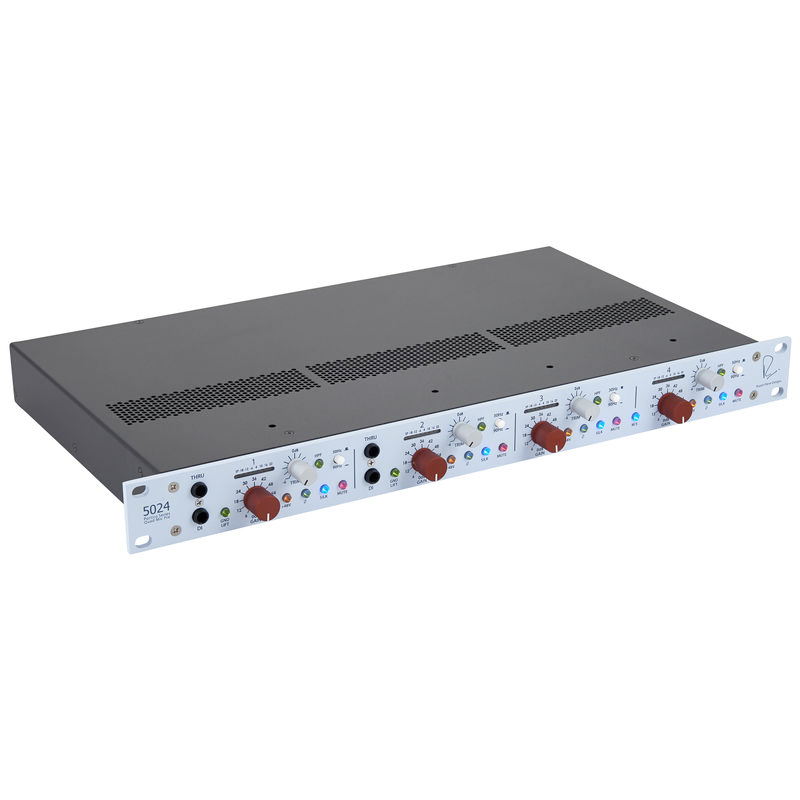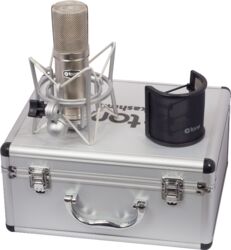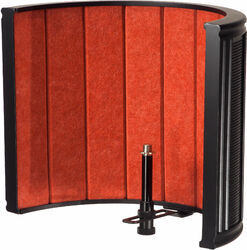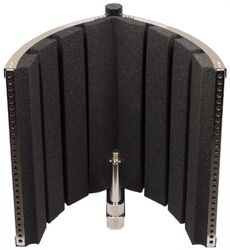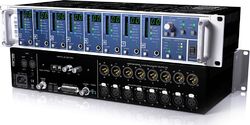Uw mand
Rupert neve design PORTICO 5024
- Lees recensies (0)
- Gerelateerde accessoires
- Vergelijkbare producten
- Gratis bezorging
- Gegarandeerd lage prijzen
- Tevreden of terugbetaald
- 3 jaar garantie
Op dit moment niet beschikbaar
neem contact op met ons
Voorraad in de winkel
Niet verkrijgbaar in de winkel
INFORMEER MIJ OVER HAAR BINNENKOMST OP VOORRAAD
Ik wil per e-mail op de hoogte worden gehouden
Go
Variatie(s) van dit product.
Het merk Rupert neve design
Leer meer over het merk Rupert neve design en ontdek de volledige catalogus.
Het grootste netwerk van winkels in Frankrijk
Vind alle informatie over onze superstores en onze gespecialiseerde boetieks.
Neem contact op met een deskundige
Onze muzikanten en enthousiaste teleconsulenten staan ??klaar om al je vragen te beantwoorden.
Voorversterker
Incorporating four channels of renowned preamplification, independent silk controls, two channels of DI inputs, and an M-S Decoder into a 1U enclosure, the 5024 is workhorse equipped to enhance the front end performance of any digital or analogue recording system. Each channel of the Portico 5024 is based around the custom transformers and class-A circuitry found in the 5012.
In addition to 72 dB of gain, the 5024’s mic pres include individually selectable phase, mute, phantom power, a selectable frequency high pass filter, and the Silk circuit which yields the rich warmth and presence of the renowned classic designs. Channels 1 & 2 of the 5024 feature a high-Z input designed for instrument level sources. Channels 3 & 4 feature an M-S switch, which enables Mid-Side decoding without the use of multiple console channels.
Microphone Input
The microphone input is balanced but not floating, being a variant of an instrumentation amplifer using a “Transformer-Like-Amplifier” (T.L.A.) configuration with a toroidal Common Mode Rejection Low Pass Filter that excludes frequencies above 150 kHz.
The T.L.A. is followed by an actual input transformer permitting a full +25 dBu input signal to be handled at unity gain without an input pad over the whole audio spectrum. This combines the advantages of both an “Electronically Balanced” and true transformer input. When the Phantom voltage is switched off, this input serves as a very high quality line input with an impedance of 10,000 ohms.
Low Noise, Low Distortion Operation
Much care was given in designing the 5012 to produce as little noise and non-harmonic distortion as possible. Carefully implemented signal paths and Class A operation are a large part of the 5024?s sweet, whisper quiet performance. For more information, go to Mr. Rupert Neve’s Design Notes
Why Transformers?
A complete discussion on transformers is out of place at this point but a technical discussion will be posted at a later date. Here it is helpful to review some of the essentials where it will be seen that a design needs to be viewed as a whole, not simply from the point of view of a single component.
The fine subtleties of circuit design relating to sonic performance are gradually becoming more clearly understood. For example, research has shown conclusively that frequencies above 20 kHz affect the way in which humans perceive sound quality. But, long before scientific evidence emerged a substantial body of musicians and engineers knew that equipment with apparently the same technical measurements could sound very different.
Incredibly small amounts of musically dissonant odd harmonics have a disastrous effect on the sound quality. Extraneous noise or interference that finds its way into a signal path seriously impairs performance of the whole chain.
Many control rooms make use of outboard gear that is not well protected from external signals. Poor grounding of such equipment can be a serious problem. “Electronically balanced” circuits much used in modern equipment, can give very good measurements on the test bench but they do not provide adequate rejection of the stray fields found in every working environment.
Input and output circuits must be freed from ground dependence so that only the “wanted” signal enters and leaves the processing path. Transformers are the ideal solution. The sweet and silky sound of my classic old favorite consoles was achieved with big transistors and large high quality transformers. Rupert Neve Designs Portico modules achieve similar quality today without the bulk or the cost.
In order that modules can work together as would be expected (i.e. in a proprietary console configuration) without producing hum, R.F. interference, or other interactions, the connecting interfaces, grounding, levels and impedances must receive careful attention. Each Portico module is a complete integral signal processor that delivers its specified performance independently. This is one of the reasons we use transformers.
In addition to 72 dB of gain, the 5024’s mic pres include individually selectable phase, mute, phantom power, a selectable frequency high pass filter, and the Silk circuit which yields the rich warmth and presence of the renowned classic designs. Channels 1 & 2 of the 5024 feature a high-Z input designed for instrument level sources. Channels 3 & 4 feature an M-S switch, which enables Mid-Side decoding without the use of multiple console channels.
Microphone Input
The microphone input is balanced but not floating, being a variant of an instrumentation amplifer using a “Transformer-Like-Amplifier” (T.L.A.) configuration with a toroidal Common Mode Rejection Low Pass Filter that excludes frequencies above 150 kHz.
The T.L.A. is followed by an actual input transformer permitting a full +25 dBu input signal to be handled at unity gain without an input pad over the whole audio spectrum. This combines the advantages of both an “Electronically Balanced” and true transformer input. When the Phantom voltage is switched off, this input serves as a very high quality line input with an impedance of 10,000 ohms.
Low Noise, Low Distortion Operation
Much care was given in designing the 5012 to produce as little noise and non-harmonic distortion as possible. Carefully implemented signal paths and Class A operation are a large part of the 5024?s sweet, whisper quiet performance. For more information, go to Mr. Rupert Neve’s Design Notes
Why Transformers?
A complete discussion on transformers is out of place at this point but a technical discussion will be posted at a later date. Here it is helpful to review some of the essentials where it will be seen that a design needs to be viewed as a whole, not simply from the point of view of a single component.
The fine subtleties of circuit design relating to sonic performance are gradually becoming more clearly understood. For example, research has shown conclusively that frequencies above 20 kHz affect the way in which humans perceive sound quality. But, long before scientific evidence emerged a substantial body of musicians and engineers knew that equipment with apparently the same technical measurements could sound very different.
Incredibly small amounts of musically dissonant odd harmonics have a disastrous effect on the sound quality. Extraneous noise or interference that finds its way into a signal path seriously impairs performance of the whole chain.
Many control rooms make use of outboard gear that is not well protected from external signals. Poor grounding of such equipment can be a serious problem. “Electronically balanced” circuits much used in modern equipment, can give very good measurements on the test bench but they do not provide adequate rejection of the stray fields found in every working environment.
Input and output circuits must be freed from ground dependence so that only the “wanted” signal enters and leaves the processing path. Transformers are the ideal solution. The sweet and silky sound of my classic old favorite consoles was achieved with big transistors and large high quality transformers. Rupert Neve Designs Portico modules achieve similar quality today without the bulk or the cost.
In order that modules can work together as would be expected (i.e. in a proprietary console configuration) without producing hum, R.F. interference, or other interactions, the connecting interfaces, grounding, levels and impedances must receive careful attention. Each Portico module is a complete integral signal processor that delivers its specified performance independently. This is one of the reasons we use transformers.
Lire la suite
Technische Specificities
- Soort voorversterker Transistor
- 4 Balanced XLR inputs
- 4 Balanced XLR outputs
- 2x 6.3 mm jack Hi-Z instrument input
- 2x 6.3 mm jack output thru
- Individually switchable phase, mute, +48 V phantom power
- Switchable high-pass filter frequency
- Hi-Z instrument input on channel 1 + 2
- Ms Decoder
- Ms Switch on channel 3 + 4
- Level meter
- Design: 19" / 1 U


